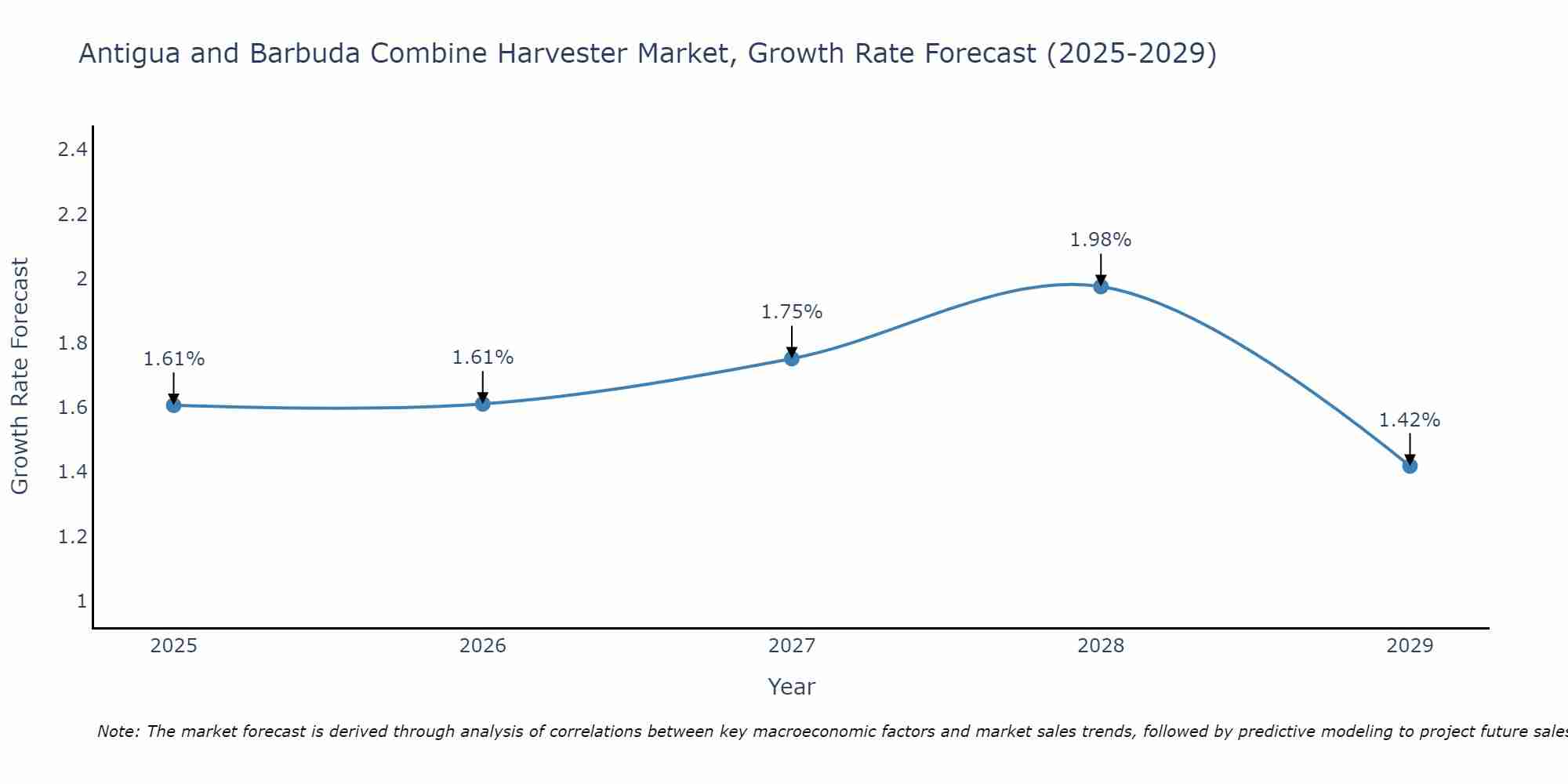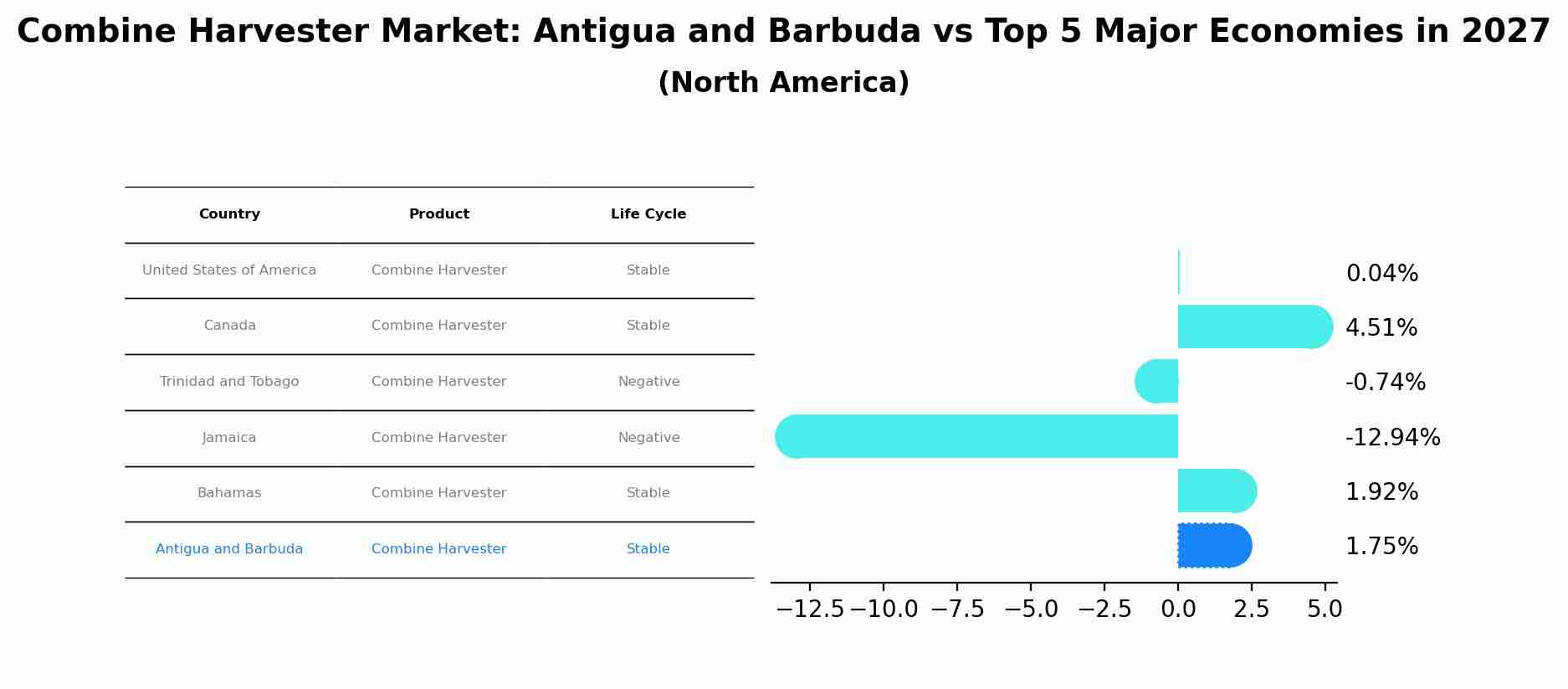Antigua and Barbuda Combine Harvester Market (2025-2031) | Forecast, Outlook, Share, Segmentation, Analysis, Value, Size, Industry, Companies, Growth, Revenue & Trends
| Product Code: ETC5398201 | Publication Date: Nov 2023 | Updated Date: Oct 2025 | Product Type: Market Research Report | |
| Publisher: 6Wresearch | Author: Bhawna Singh | No. of Pages: 60 | No. of Figures: 30 | No. of Tables: 5 |
Antigua and Barbuda Combine Harvester Market Size Growth Rate
The Antigua and Barbuda Combine Harvester Market is projected to witness mixed growth rate patterns during 2025 to 2029. The growth rate begins at 1.61% in 2025, climbs to a high of 1.98% in 2028, and moderates to 1.42% by 2029.

Combine Harvester Market: Antigua and Barbuda vs Top 5 Major Economies in 2027 (North America)
Antigua and Barbuda's Combine Harvester market is anticipated to experience a stable growth rate of 1.75% by 2027, reflecting trends observed in the largest economy United States of America, followed by Canada, Trinidad and Tobago, Jamaica and Bahamas.

Antigua and Barbuda Combine Harvester Market Oveview
The combine harvester market in Antigua and Barbuda is essential for the agricultural sector, providing efficient solutions for crop harvesting. These machines combine three harvesting operations reaping, threshing, and winnowing into a single process, significantly improving productivity. The market growth is driven by the need for modern agricultural equipment to support large-scale farming operations. Innovations in combine harvester technology, such as enhanced fuel efficiency and automated controls, are key trends in this market.
Drivers of the market
The combine harvester market in Antigua and Barbuda is driven by the increasing adoption of mechanized farming practices to enhance agricultural productivity. The need to improve harvesting efficiency and reduce labor dependency fuels the demand for combine harvesters. Government initiatives and subsidies to promote modern agricultural equipment also support market growth. Technological advancements in combine harvesters, offering improved performance, precision, and ease of operation, further drive the market. Additionally, the growing awareness among farmers about the benefits of using combine harvesters, such as time and cost savings, contributes to the markets expansion.
Challenges of the market
The combine harvester market in Antigua and Barbuda is challenged by the small scale of agricultural activities. The high cost of combine harvesters makes them unaffordable for many small farmers, leading to a low adoption rate. Additionally, the lack of financing options and government subsidies further restricts access to modern agricultural machinery. Maintenance and spare parts availability also pose significant challenges due to the dependence on imports and limited local support infrastructure.
Government Policy of the market
In the combine harvester market, government policies in Antigua and Barbuda aim to support agricultural productivity and sustainability. Subsidies and financial incentives are offered to farmers for purchasing modern combine harvesters. Policies also promote the use of efficient and environmentally friendly agricultural machinery. Import regulations ensure that combine harvesters meet quality and safety standards. Additionally, the government provides training programs for farmers to enhance their skills in operating and maintaining modern agricultural equipment.
Key Highlights of the Report:
- Antigua and Barbuda Combine Harvester Market Outlook
- Market Size of Antigua and Barbuda Combine Harvester Market, 2024
- Forecast of Antigua and Barbuda Combine Harvester Market, 2031
- Historical Data and Forecast of Antigua and Barbuda Combine Harvester Revenues & Volume for the Period 2021-2031
- Antigua and Barbuda Combine Harvester Market Trend Evolution
- Antigua and Barbuda Combine Harvester Market Drivers and Challenges
- Antigua and Barbuda Combine Harvester Price Trends
- Antigua and Barbuda Combine Harvester Porter`s Five Forces
- Antigua and Barbuda Combine Harvester Industry Life Cycle
- Historical Data and Forecast of Antigua and Barbuda Combine Harvester Market Revenues & Volume By Cutting Width for the Period 2021-2031
- Historical Data and Forecast of Antigua and Barbuda Combine Harvester Market Revenues & Volume By Small Size Combine Harvester for the Period 2021-2031
- Historical Data and Forecast of Antigua and Barbuda Combine Harvester Market Revenues & Volume By Large Size Combine Harvester for the Period 2021-2031
- Historical Data and Forecast of Antigua and Barbuda Combine Harvester Market Revenues & Volume By Type for the Period 2021-2031
- Historical Data and Forecast of Antigua and Barbuda Combine Harvester Market Revenues & Volume By Wheel Type Combine Harvester for the Period 2021-2031
- Historical Data and Forecast of Antigua and Barbuda Combine Harvester Market Revenues & Volume By Crawler Type Combine Harvester for the Period 2021-2031
- Historical Data and Forecast of Antigua and Barbuda Combine Harvester Market Revenues & Volume By Power Source for the Period 2021-2031
- Historical Data and Forecast of Antigua and Barbuda Combine Harvester Market Revenues & Volume By Tractor Pulled/PTO Powered Combine Harvester for the Period 2021-2031
- Historical Data and Forecast of Antigua and Barbuda Combine Harvester Market Revenues & Volume By Self-Propelled Combine Harvester for the Period 2021-2031
- Antigua and Barbuda Combine Harvester Import Export Trade Statistics
- Market Opportunity Assessment By Cutting Width
- Market Opportunity Assessment By Type
- Market Opportunity Assessment By Power Source
- Antigua and Barbuda Combine Harvester Top Companies Market Share
- Antigua and Barbuda Combine Harvester Competitive Benchmarking By Technical and Operational Parameters
- Antigua and Barbuda Combine Harvester Company Profiles
- Antigua and Barbuda Combine Harvester Key Strategic Recommendations
Frequently Asked Questions About the Market Study (FAQs):
1 Executive Summary |
2 Introduction |
2.1 Key Highlights of the Report |
2.2 Report Description |
2.3 Market Scope & Segmentation |
2.4 Research Methodology |
2.5 Assumptions |
3 Antigua and Barbuda Combine Harvester Market Overview |
3.1 Antigua and Barbuda Country Macro Economic Indicators |
3.2 Antigua and Barbuda Combine Harvester Market Revenues & Volume, 2021 & 2031F |
3.3 Antigua and Barbuda Combine Harvester Market - Industry Life Cycle |
3.4 Antigua and Barbuda Combine Harvester Market - Porter's Five Forces |
3.5 Antigua and Barbuda Combine Harvester Market Revenues & Volume Share, By Cutting Width, 2021 & 2031F |
3.6 Antigua and Barbuda Combine Harvester Market Revenues & Volume Share, By Type, 2021 & 2031F |
3.7 Antigua and Barbuda Combine Harvester Market Revenues & Volume Share, By Power Source, 2021 & 2031F |
4 Antigua and Barbuda Combine Harvester Market Dynamics |
4.1 Impact Analysis |
4.2 Market Drivers |
4.2.1 Increasing adoption of mechanized farming practices |
4.2.2 Government support and subsidies for agricultural mechanization |
4.2.3 Growing demand for efficient harvesting equipment in the agriculture sector in Antigua and Barbuda |
4.3 Market Restraints |
4.3.1 High initial investment cost of combine harvesters |
4.3.2 Limited availability of skilled operators for combine harvesters |
4.3.3 Dependence on imported machinery and spare parts for maintenance and repairs |
5 Antigua and Barbuda Combine Harvester Market Trends |
6 Antigua and Barbuda Combine Harvester Market Segmentations |
6.1 Antigua and Barbuda Combine Harvester Market, By Cutting Width |
6.1.1 Overview and Analysis |
6.1.2 Antigua and Barbuda Combine Harvester Market Revenues & Volume, By Small Size Combine Harvester, 2021-2031F |
6.1.3 Antigua and Barbuda Combine Harvester Market Revenues & Volume, By Large Size Combine Harvester, 2021-2031F |
6.2 Antigua and Barbuda Combine Harvester Market, By Type |
6.2.1 Overview and Analysis |
6.2.2 Antigua and Barbuda Combine Harvester Market Revenues & Volume, By Wheel Type Combine Harvester, 2021-2031F |
6.2.3 Antigua and Barbuda Combine Harvester Market Revenues & Volume, By Crawler Type Combine Harvester, 2021-2031F |
6.3 Antigua and Barbuda Combine Harvester Market, By Power Source |
6.3.1 Overview and Analysis |
6.3.2 Antigua and Barbuda Combine Harvester Market Revenues & Volume, By Tractor Pulled/PTO Powered Combine Harvester, 2021-2031F |
6.3.3 Antigua and Barbuda Combine Harvester Market Revenues & Volume, By Self-Propelled Combine Harvester, 2021-2031F |
7 Antigua and Barbuda Combine Harvester Market Import-Export Trade Statistics |
7.1 Antigua and Barbuda Combine Harvester Market Export to Major Countries |
7.2 Antigua and Barbuda Combine Harvester Market Imports from Major Countries |
8 Antigua and Barbuda Combine Harvester Market Key Performance Indicators |
8.1 Average age of combine harvesters in use |
8.2 Adoption rate of mechanized farming practices in the agriculture sector |
8.3 Utilization rate of combine harvesters in the field |
9 Antigua and Barbuda Combine Harvester Market - Opportunity Assessment |
9.1 Antigua and Barbuda Combine Harvester Market Opportunity Assessment, By Cutting Width, 2021 & 2031F |
9.2 Antigua and Barbuda Combine Harvester Market Opportunity Assessment, By Type, 2021 & 2031F |
9.3 Antigua and Barbuda Combine Harvester Market Opportunity Assessment, By Power Source, 2021 & 2031F |
10 Antigua and Barbuda Combine Harvester Market - Competitive Landscape |
10.1 Antigua and Barbuda Combine Harvester Market Revenue Share, By Companies, 2024 |
10.2 Antigua and Barbuda Combine Harvester Market Competitive Benchmarking, By Operating and Technical Parameters |
11 Company Profiles |
12 Recommendations | 13 Disclaimer |
- Single User License$ 1,995
- Department License$ 2,400
- Site License$ 3,120
- Global License$ 3,795
Search
Thought Leadership and Analyst Meet
Our Clients
Related Reports
- Germany Breakfast Food Market (2026-2032) | Industry, Share, Growth, Size, Companies, Value, Analysis, Revenue, Trends, Forecast & Outlook
- Australia Briquette Market (2025-2031) | Growth, Size, Revenue, Forecast, Analysis, Trends, Value, Share, Industry & Companies
- Vietnam System Integrator Market (2025-2031) | Size, Companies, Analysis, Industry, Value, Forecast, Growth, Trends, Revenue & Share
- ASEAN and Thailand Brain Health Supplements Market (2025-2031) | Strategy, Consumer Insights, Analysis, Investment Trends, Opportunities, Growth, Size, Share, Industry, Revenue, Segments, Value, Segmentation, Supply, Forecast, Restraints, Outlook, Competition, Drivers, Trends, Demand, Pricing Analysis, Competitive, Strategic Insights, Companies, Challenges
- ASEAN Bearings Market (2025-2031) | Strategy, Consumer Insights, Analysis, Investment Trends, Opportunities, Growth, Size, Share, Industry, Revenue, Segments, Value, Segmentation, Supply, Forecast, Restraints, Outlook, Competition, Drivers, Trends, Demand, Pricing Analysis, Competitive, Strategic Insights, Companies, Challenges
- Europe Flooring Market (2025-2031) | Outlook, Share, Industry, Trends, Forecast, Companies, Revenue, Size, Analysis, Growth & Value
- Saudi Arabia Manlift Market (2025-2031) | Outlook, Size, Growth, Trends, Companies, Industry, Revenue, Value, Share, Forecast & Analysis
- Uganda Excavator, Crane, and Wheel Loaders Market (2025-2031) | Strategy, Consumer Insights, Analysis, Investment Trends, Opportunities, Growth, Size, Share, Industry, Revenue, Segments, Value, Segmentation, Supply, Forecast, Restraints, Outlook, Competition, Drivers, Trends, Demand, Pricing Analysis, Competitive, Strategic Insights, Companies, Challenges
- Rwanda Excavator, Crane, and Wheel Loaders Market (2025-2031) | Strategy, Consumer Insights, Analysis, Investment Trends, Opportunities, Growth, Size, Share, Industry, Revenue, Segments, Value, Segmentation, Supply, Forecast, Restraints, Outlook, Competition, Drivers, Trends, Demand, Pricing Analysis, Competitive, Strategic Insights, Companies, Challenges
- Kenya Excavator, Crane, and Wheel Loaders Market (2025-2031) | Strategy, Consumer Insights, Analysis, Investment Trends, Opportunities, Growth, Size, Share, Industry, Revenue, Segments, Value, Segmentation, Supply, Forecast, Restraints, Outlook, Competition, Drivers, Trends, Demand, Pricing Analysis, Competitive, Strategic Insights, Companies, Challenges
Industry Events and Analyst Meet
Whitepaper
- Middle East & Africa Commercial Security Market Click here to view more.
- Middle East & Africa Fire Safety Systems & Equipment Market Click here to view more.
- GCC Drone Market Click here to view more.
- Middle East Lighting Fixture Market Click here to view more.
- GCC Physical & Perimeter Security Market Click here to view more.
6WResearch In News
- Doha a strategic location for EV manufacturing hub: IPA Qatar
- Demand for luxury TVs surging in the GCC, says Samsung
- Empowering Growth: The Thriving Journey of Bangladesh’s Cable Industry
- Demand for luxury TVs surging in the GCC, says Samsung
- Video call with a traditional healer? Once unthinkable, it’s now common in South Africa
- Intelligent Buildings To Smooth GCC’s Path To Net Zero


















